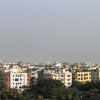UNDP suggests stronger urban governance for Bangladesh
Bangladesh, like most other Asian countries, witnessed a rapid rise in urban population, a fact that requires stronger urban governance to make the cities liveable and thriving, said a new report of the United Nations Development Programme (UNDP).
Urban population in Bangladesh now stands at 55 million and is likely to jump to 83.2 million in 2030 and 112.4 million in 2050, said the Asia-Pacific Human Development Report (APHDR) launched in the city's Sonargaon Hotel yesterday.
The share of urban population would grow from existing 34 percent to 45 percent and 56 percent in 2030 and 2050 respectively, said the report titled “Shaping the future: how changing demographics can power human development.”
The report focused on how the Asia Pacific region with its large youth and working age population (66 percent of population in Bangladesh aged between 15 and 64 years) could make enormous contributions to the socioeconomic development.
It also presented challenges faced by the cities in addition to recommending ways to address those to make development sustainable, which left none out of its benefits.
“If urbanisation is not well managed soon, the region is not likely to sustain the momentum of economic growth or human development and will lose some of its demographic dividend,” said Thangavel Palanivel, lead author of the APHDR.
Success would depend strongly on a national legal foundation, capable institutions, and adequate financial instruments to manage decentralisation and coordinate among different levels of government, said Palanivel, chief economist of the UNDP Regional Bureau for Asia and Pacific.
The report further said poor education, declining agricultural productivity, low incomes from farming and environmental factors drive the rural people to the cities, which however often do not provide better conditions in the regional countries.
Many towns and cities suffer from relatively poor standards in terms of public water supply, sanitation, drainage and waste management services, it added.
Citing an example, the report says about 55 percent of urban residents in Bangladesh and Nepal struggle to survive in slums.
Shares of slum dwellers have dropped in some cases, but the numbers had gone up. In Bangladesh, the number climbed from 20 million to 29 million from 1990 to 2014, it said.
According to the World Health Organization, Dhaka was one of the 20 most polluted cities in 2014.
The report said with urban expansion, the problem of huge solid waste would be acute in the coming days. Therefore, the cities would need to develop ways to both manage and decrease waste, including recycling the waste.
It added that urban infrastructure was often ill-equipped to deal with natural disasters, and for the poor the risks were even greater.
“With limited savings or coverage by social safety nets, they may be unable to recover from a disaster, which can perpetuate the cycle of poverty and limit human development across generations,” the report observed.
The UNDP report suggested that better city planning, early warning systems and effective urban governance would help reduce the risks.
Economist Prof Wahiduddin Mahmud expressed concern over the unplanned urbanisation of Dhaka, and said it was densely populated without adequate amenities.
“Can we really afford a megacity like Dhaka?” he asked while addressing a panel discussion.
He suggested higher resources allocation on quality education and health.
Mashiur Rahman, economic affairs adviser of the prime minister of Bangladesh, Haoliang Xu, director of the UNDP Regional Bureau for Asia and Pacific, Robert Watkins, UN resident coordinator in Bangladesh, Pauline Tamesis, country director of UNDP Bangladesh, also spoke at the programme.

 For all latest news, follow The Daily Star's Google News channel.
For all latest news, follow The Daily Star's Google News channel. 








Comments